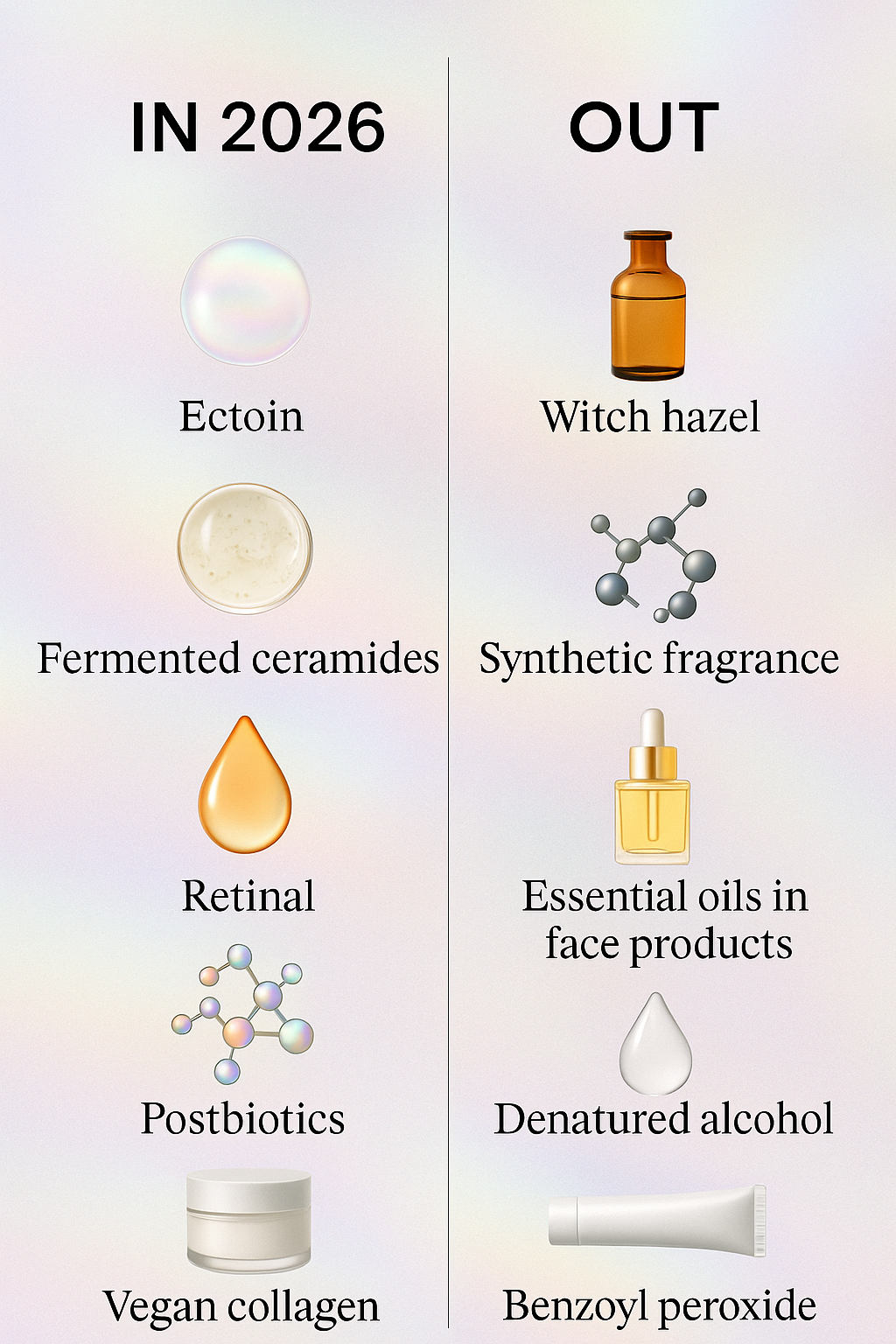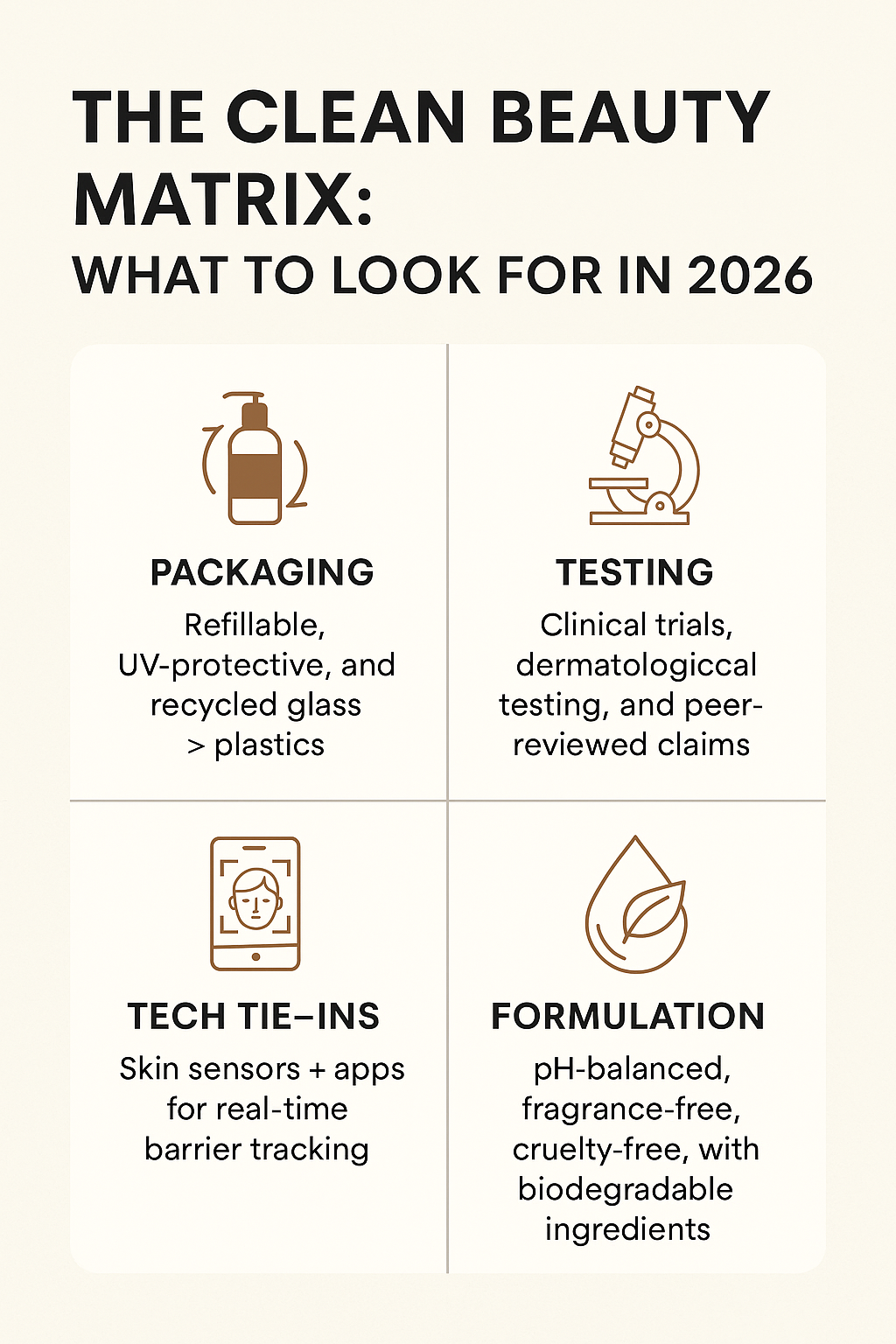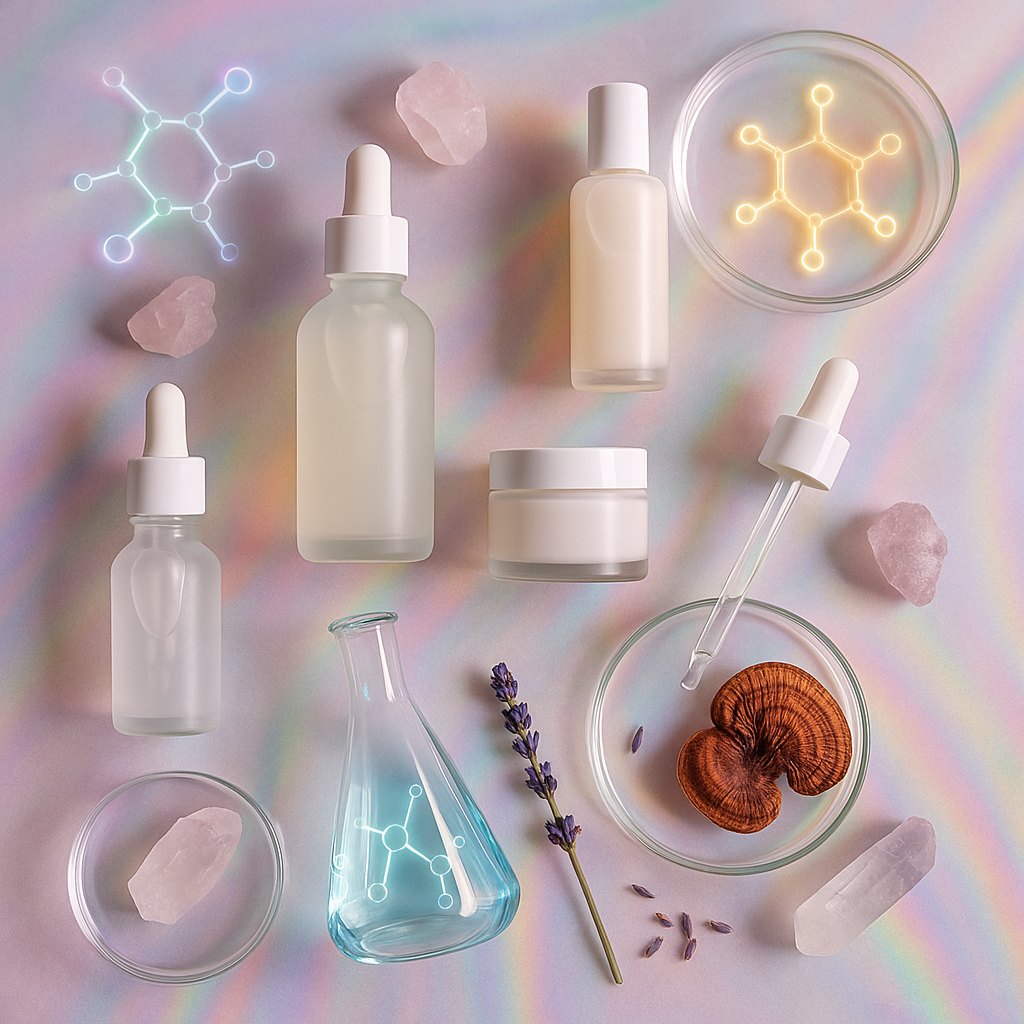2026 is the year clinical clean beauty takes center stage. Gone are the days of vague “natural” claims—today’s science-based skincare is smarter, safer, and tuned to your hormones, microbiome, and mood. From psychodermatology to biotech breakthroughs, here’s how the next-gen beauty movement is rewriting the rules—for glowing, sensitive, and sustainably radiant skin.

1. The Rise of Hormone-Safe Skincare
Hormone-safe skincare in 2026 avoids endocrine disruptors like parabens and phthalates, instead using clean, bioactive alternatives that support hormonal balance—especially for sensitive, acne-prone, or menopausal skin.
Your skin is your largest endocrine organ, and with the rise in hormone-related conditions, the beauty world is finally taking this seriously. Skincare products that actively support, rather than interfere with, hormonal equilibrium are becoming the new gold standard. Previously overlooked ingredients such as parabens, phthalates, and synthetic fragrance are now recognized as hormone disruptors. These chemicals are known to mimic or interfere with the body’s natural hormone function, particularly estrogen and androgen pathways.
As a result, brands are replacing these controversial ingredients with plant-based bioactives, safer preservatives like potassium sorbate, and calming agents that are free from essential oils. These formulas cater specifically to hormonally sensitive skin, which may become reactive during menstruation, menopause, or periods of high stress. Brands with transparent lab testing, COSMOS certifications, and hormone-safe labels are gaining popularity for their commitment to long-term wellbeing, not just superficial results.
The Environmental Working Group has emphasized the need for global reform, reporting over 85,000 unregulated ingredients in cosmetics used across the U.S. This has prompted a shift toward European-style regulation, where ingredient safety is held to higher standards. For those navigating hormone imbalances, acne, or perimenopause, choosing skincare that’s intentionally hormone-safe is now a critical step in any modern beauty ritual.
2. Psychodermatology Is Booming: Skincare for the Nervous System
Psychodermatology skincare supports emotional wellbeing by reducing stress through adaptogens, magnesium, and mood-calming topicals.
The emerging field of psychodermatology is transforming how we approach skin health. Rooted in the connection between the brain and the skin—both of which originate from the same embryonic layer known as the ectoderm—this approach recognizes that our emotional state has a direct impact on our skin’s condition. Anxiety, depression, and chronic stress are now acknowledged as triggers for breakouts, rashes, and sensitivity.
In response, psychodermatology skincare uses functional ingredients that calm the nervous system while reinforcing the skin barrier. Adaptogens such as ashwagandha, reishi mushroom, and holy basil help regulate the body’s stress response, reducing cortisol levels that may otherwise inflame the skin. Products that support GABA production—the neurotransmitter responsible for calmness—are also gaining ground. Instead of relying on essential oils or aggressive actives, these formulas are gentle, scentless, and deeply soothing.
Hero ingredients in this category include niacinamide, which supports both the skin barrier and mental calm; magnesium, which works topically and internally to reduce stress; Centella Asiatica (also known as cica), a powerhouse for trauma-related skin healing; and beta-glucans from oats or mushrooms, which strengthen skin immunity.
Clinical research backs these claims. A 2023 review in the Journal of Cosmetic Dermatology found that individuals with sensitive skin experienced a 35 percent reduction in anxiety after using psychodermatology topicals, confirming what many holistic practitioners have long believed: when you calm the mind, the skin follows.

3. Microbiome-First Formulas: Friendly Bacteria for Glowing Skin
Skincare microbiome support means using products that preserve and enhance the living ecosystem of your skin. This helps reduce acne, eczema, and inflammation.
The skin’s microbiome is a delicate yet powerful ecosystem of bacteria, fungi, and microorganisms that play a vital role in maintaining barrier function, hydration, and immune defense. Disruption of this microbial balance—whether through over-cleansing, harsh exfoliants, or antibacterial ingredients—can lead to common issues such as acne, rosacea, and eczema.
In 2026, skincare is shifting toward a symbiotic relationship with these microbes rather than attempting to sterilize the skin. Microbiome-first formulas are designed to nurture this living layer. One of the biggest trends is the use of postbiotic-infused moisturizers, which feed the good bacteria and help regulate inflammation. Cleansers are becoming gentler, with pH values around 5.5 to avoid stripping natural oils. Live probiotic sprays, especially those containing strains like Lactobacillus reuteri, are gaining traction for their ability to reset the skin’s immune responses.
To maintain a healthy skin microbiome, it’s now advised to steer clear of foaming cleansers and drying toners, especially those containing witch hazel or alcohol. Instead, dermatologists recommend a double-cleansing approach using oil-based followed by milk-based cleansers, which effectively remove makeup and pollutants without disrupting the microbial flora. Labels such as “microbiome-safe,” “postbiotic,” or “dermatologically balanced” are becoming the new markers of truly clean skincare.
A 2025 DermTech report revealed that microbiome-targeted skincare saw a 54 percent rise in global search volume during the first quarter alone. The demand is clear—people are seeking a gentler, science-backed approach that respects the skin’s natural intelligence.
4. Biotech Beauty: Where Clean Meets Clinical
Biotech skincare uses lab-grown molecules and ingredients that mimic nature without harming the environment—bringing high potency and precision to clean beauty.
Biotech beauty represents the intersection of sustainability and scientific advancement. By leveraging bioengineering, brands can replicate powerful natural compounds in laboratories—avoiding overharvesting, deforestation, and crop instability. The result is a cleaner, more ethical product that delivers clinical-level results without compromising the planet.
Some of the most exciting biotech ingredients include bio-fermented hyaluronic acid, which offers deep hydration and is sustainably grown without animal derivatives. Lab-grown collagen peptides are replacing traditional marine and bovine sources, making anti-aging skincare more accessible and eco-conscious. Synthetic snail mucin analogues offer the regenerative properties of the original, without exploiting animals. Meanwhile, growth factor mimetics—derived from algae and plant stem cells—are leading the way in advanced cellular repair.
These ingredients aren’t just clean—they’re potent. Brands like Nooance Paris are leading the charge with peptide-rich, science-first skincare. Allies of Skin continues to innovate with antioxidant-heavy, clinical-strength formulas. Bioeffect, known for its EGF technology sourced from barley, is proving that biotech beauty can be as luxurious as it is effective.
Another major advantage of biotech formulations is their shelf stability and reduced allergenicity. With fewer impurities and more controlled production, these products are ideal for sensitive skin and deliver consistent results with every use.
5. Skin Longevity: Anti-Aging Is Out. Cell Rejuvenation Is In.
Skin longevity focuses on preserving radiance, elasticity, and resilience rather than erasing age—using ingredients that support cellular health over time.
The beauty industry is undergoing a paradigm shift. Rather than chasing wrinkle-free perfection, the new focus is on maintaining long-term skin health and vitality—what experts are calling “skinspan.” Inspired by research in longevity science, skinspan refers to the functional age of your skin, not just how it looks but how well it performs over time.
Modern longevity-focused skincare aims to prevent cellular senescence, a state where cells stop dividing and begin to secrete inflammatory signals. Ingredients like NAD+ boosters help fuel mitochondrial function, while peptides trigger collagen synthesis and support skin elasticity. Retinal, a stabilized and gentler cousin of retinol, is becoming the gold standard for age-conscious skincare. It delivers powerful results without the irritation associated with traditional retinoids.
Brands are also exploring cellular-level biohacks inspired by leaders in the longevity space, such as Dr. David Sinclair. Companies like OneSkin, Caldera + Lab, and Futurewise are formulating products with a focus on rejuvenating skin at the deepest layers, not simply masking surface-level aging.
This is not about anti-aging—it’s about pro-longevity. It’s about empowering your skin to thrive across every stage of life.
6. Skincare & Circadian Rhythms: Timing Is Everything
A growing body of research shows that your skin has its own circadian rhythm—biological cycles that follow the 24-hour day and influence cellular repair, hydration levels, and barrier function. Just as our bodies rely on sleep-wake cycles to regulate health, our skin performs different tasks depending on the time of day. Daytime is about defense. Nighttime is for regeneration.
Brands are formulating products specifically for AM or PM use, aligning ingredients with the skin’s natural cycles. Morning routines now emphasize lightweight antioxidants like vitamin C, niacinamide, and protective ceramides. Evening products prioritize actives like peptides, retinal, or NAD+ boosters—chosen for their ability to enhance recovery while you sleep.
Syncing your skincare to your body’s internal clock not only improves results, it reinforces your connection to your body’s rhythms—fusing wellness with science at the cellular level.
7. Detoxing from Cleanwashing: How to Tell What’s Actually Safe
As clean beauty becomes mainstream, it’s also become increasingly confusing. With no universal definition of “clean,” many brands lean into what’s called cleanwashing—using vague buzzwords like “natural,” “green,” or “plant-based” without meaningful formulation changes.
To navigate the noise, it helps to spot red flags. Be wary of products that focus heavily on branding but offer no published ingredient breakdown. “Fragrance” as a single-line ingredient can hide dozens of chemical compounds, some of which may be hormone-disrupting. Avoid brands that tout “chemical-free” claims—everything, including water, is a chemical.
True clean beauty in 2026 means products that are proven safe for your hormones, microbiome, and nervous system—verified not by marketing, but by science. Tools like INCI decoders, EWG ratings, and dermatologically approved certifications are now part of every informed shopper’s toolkit.
8. The Science of Texture: Why Formulation Feel Matters
Clean beauty is no longer judged solely by its ingredients—it’s also about how it feels on your skin. In 2026, texture isn’t just a luxury detail—it’s a matter of compliance, comfort, and accessibility.
Emerging formulation science is focusing on tactile elegance. We’re seeing the rise of ultra-light gel-creams designed for oily, acne-prone, or hormone-sensitive skin types. At the other end of the spectrum, waterless balms and barrier-rich emollients cater to those dealing with barrier repair or post-retinoid recovery.
Neurocosmetic brands are beginning to test for sensory overstimulation, removing ingredients that cause stinging, tingling, or intense cooling. Texture is quickly becoming the new frontier in clean, inclusive skincare.
9. Ingredient Spotlight: What’s In, What’s Out in 2026
The clean beauty shelves of 2026 look radically different from a decade ago. Gone are the harsh ingredients once justified in the name of efficacy. In their place? A new wave of gentle, clinically validated bioactives designed to respect both skin health and hormonal harmony.
IN:
- Ectoin
- Fermented ceramides
- Retinal
- Postbiotics and L. reuteri
- Vegan collagen peptides
OUT:
- Essential oils in face products
- Witch hazel
- Synthetic fragrance
- Denatured alcohol
- Benzoyl peroxide
The shift isn’t just about trends—it’s about safety, science, and skinspan.
Final Word
Let your skin breathe, speak, glow, and evolve. Clean beauty is no longer just botanical. It’s clinical, cosmic, and conscious.
Ready to future-proof your skincare routine?
Tag @stephilareine and show us your evolved skincare shelf—we’d love to see what you’re learning, loving, and letting go of.
Suggested Reading:
Which hormones are responsible for your acne?
How Laser Skin Resurfacing Revolutionizes Skincare
Beauty Tips: Integrating Technology Into Skincare Routines
8 Everyday Habits That Secretly Damage Your Skin and Hair
Best Biohacking Tools for Women in 2025 (Tested + Approved)
Night Ease Sleep Glasses: The Cool Girl’s Guide to Biohacking Better Sleep
Nooance Paris Summer 2025: My Glowing Review of the LED Mask Everyone’s Talking About
